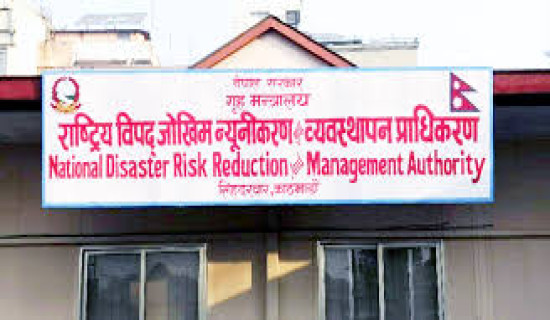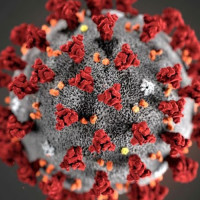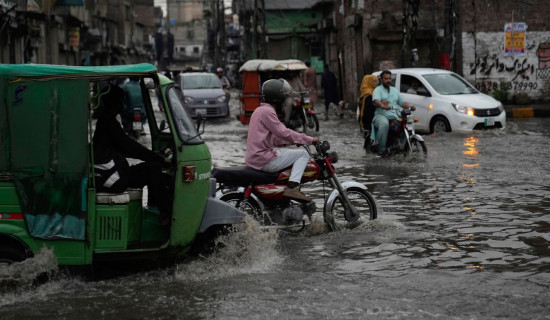- Tuesday, 1 July 2025
Air, dust pollution puts bees at grave risk
By Anil Parajuli,Hetauda, May 15: Bees, which roam in nature collecting nectar and pollen and aiding in pollination, are now under threat due to an increasingly unsuitable environment.
Air pollution reduces the fragrance of flowers, making it harder for bees to locate them, thus contributing to their decline. Air pollution has been shown to negatively affect human health, biodiversity, and climate.
Studies reveal that air pollution also disrupts the ability of bees and other pollinators, vital for crop production and biodiversity, to perform their essential roles.
According to Sujan Angai, head of the Beekeeping Development Programme in Bhandara of Chitwan, factories, highways, hospitals and dumping sites should not be located near beekeeping zones. He explained that when the surrounding environment is polluted, the honey produced by bees becomes contaminated due to the presence of foreign substances.
He further said that due to dust, smoke and pollution, both the quantity and quality of honey have declined. Although bees generally forage within a two-to-five-kilometre radius, cement industries in Hetauda’s Hatiya area, operating in densely populated zones, have failed to control dust emissions. Also, haphazard crusher operations and excessive pesticide use in agriculture have led to a decline in honey production.
Environmental expert Prof. Dr. Balram Kumar Bhatt said that although industries and factories are established with promises to control dust, smoke and chemical emissions, problems persist due to the lack of enforcement of environmental standards.
Although environmental impact assessments (EIAs) are conducted before establishing industries and entrepreneurs commit to abiding by the regulations, ineffective government monitoring means the negative effects are felt directly by the general public and wildlife.
Senior scientific officer Raghuram Parajuli from the Department of Botany in Kathmandu said that pollution (dust, smoke and other pollutants) affects plant health, which in turn impacts bees. When the ecological system is disrupted, pollination activities are also disturbed. Due to pollution, flowers may not bloom properly, or bees may not be attracted to them, affecting plant growth and development.
A research team including the UK Centre for Ecology and Hydrology (UKCEH), and the universities of Birmingham, Reading, Surrey and Southern Queensland found that ozone significantly alters the structure and scent of floral fragrances, leading to a decline in bee populations. The study revealed that ozone pollution can reduce bees’ ability to detect floral scents from a few metres away by up to 90 per cent.
Typically, nitrogen oxides emitted by vehicles and industrial processes react with volatile organic compounds released by plants in the presence of sunlight, creating ground-level ozone.
Professor Christian Pfrag from the University of Birmingham, who contributed to the study, said, “Our research provides concrete evidence that changes in flower scent due to ground-level ozone make it difficult for pollinators to play their crucial roles in natural environments.”
According to Jhalak Nath Kandel, head of the Agriculture Development Office in Chitwan, pesticide used during the blooming season of mustard flowers has impacted both bees and other insects. Without proper consultation with agricultural technicians, farmers often follow neighbours in applying pesticides, which directly affect bees.
Kandel also acknowledged that while pesticides used in farming harm bees and other pollinators, the government has not allocated a budget for detailed research on the impact, leaving experts to make only rough estimates.
Sandeep Kumar Sapkota, a professional beekeeper and bee conservation activist from Makwanpur, said that the shrinking and increasingly toxic foraging grounds have affected the entire lifecycle of bees and other pollinators. He expressed concern that the dust pollution caused by three cement factories operating in Hetauda is displacing bees from their natural habitats. Apart from domesticated bees, wild species such as cliff bees, rock bees and other native pollinators are also becoming endangered due to cement dust and environmental degradation.
Bharati Pathak, a provincial assembly member and member of the Industry, Tourism and Environment Committee, stressed the need to protect bees and called for studies and research on bee populations in Bagmati Province.
Rajkumar Malla, chairperson of Raksirang Rural Municipality in Makwanpur, where programmes like Chiuri, Bat and Chepang initiatives are ongoing, said the municipality has allocated subsidies to support designated bee foraging areas while promoting forest conservation.
Although Nepal's Beekeeping Promotion Policy 2073 (2016) mandates that at least 25 per cent of plantation programmes in agroforestry, afforestation, parks and protected natural areas should consist of bee-forage plants, Bagmati Province’s Ministry of Forests and Environment has yet to implement it. The ministry’s information officer Sanjeev Subedi admitted that despite being mentioned in the policy, it has not been implemented effectively.
The Ministry can assign environmental inspectors or designate staff to act as inspectors by completing procedures through the Public Service Commission.
Currently, 15 environmental inspectors have been appointed to 13 districts. These inspectors are responsible for verifying pollution control measures, checking illegal emissions of noise, heat or waste and ensuring that approved environmental impact conditions are met. However, these tasks have not been carried out effectively.
















